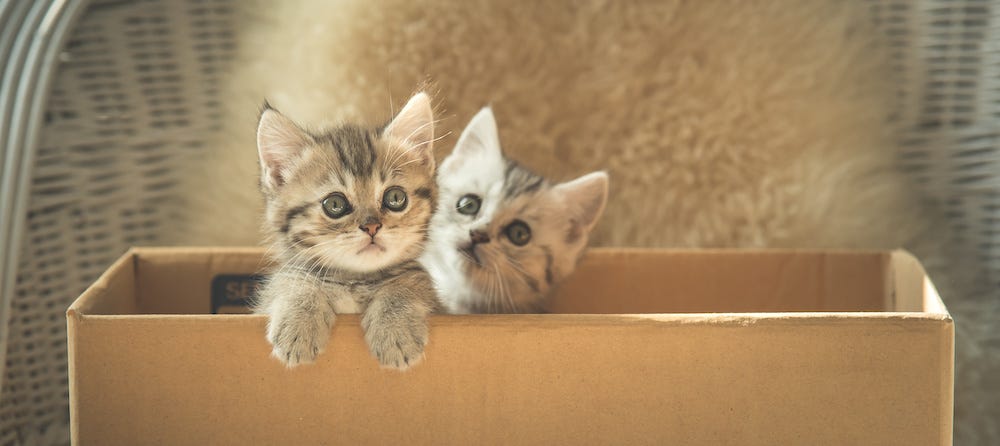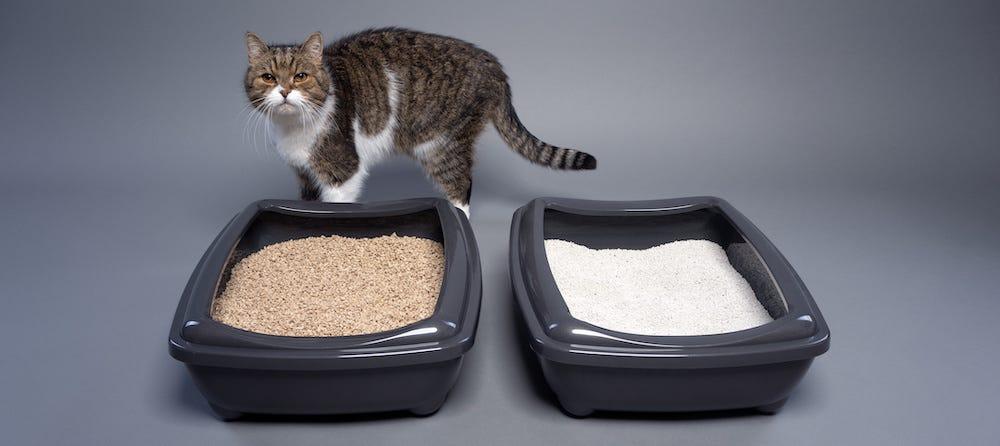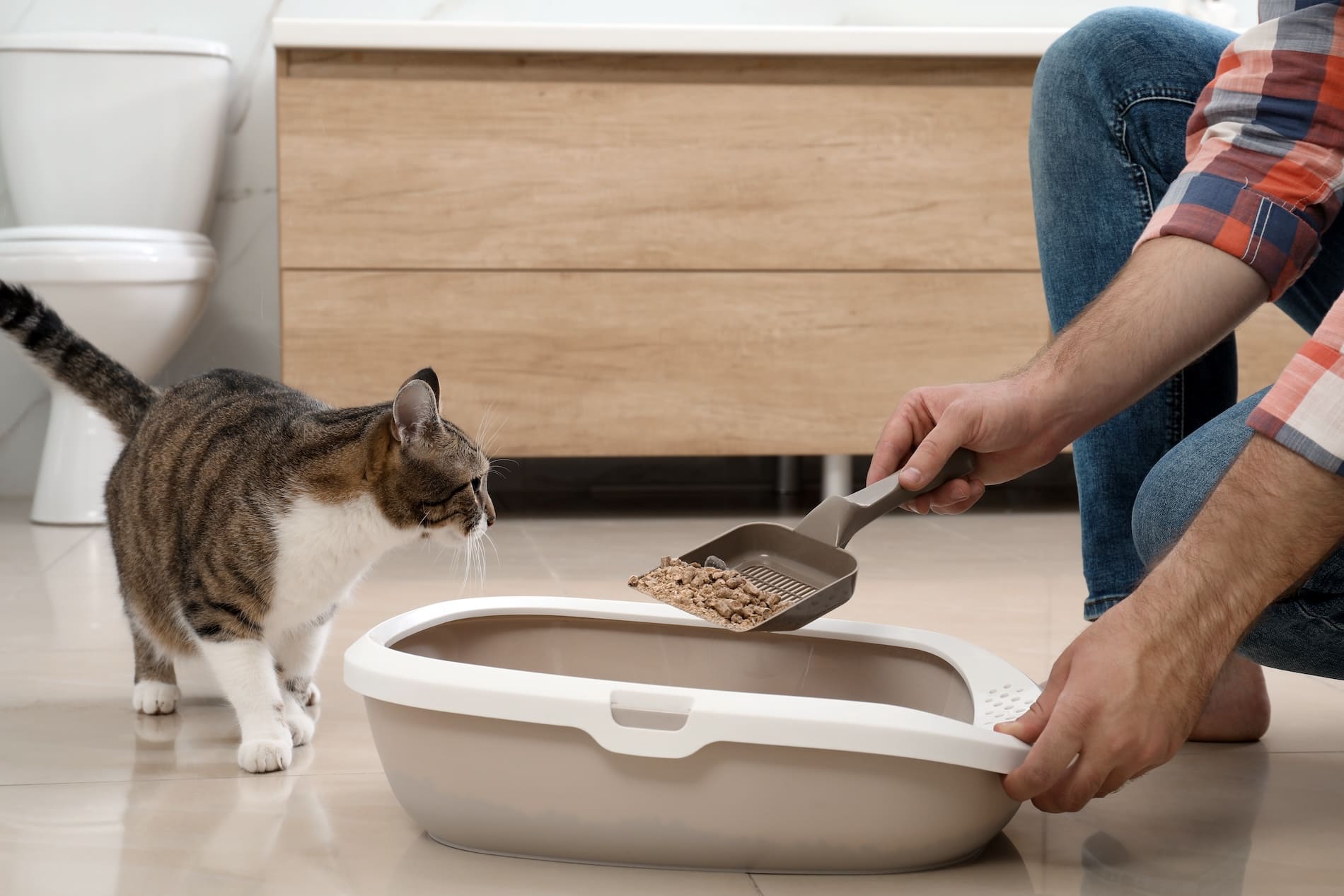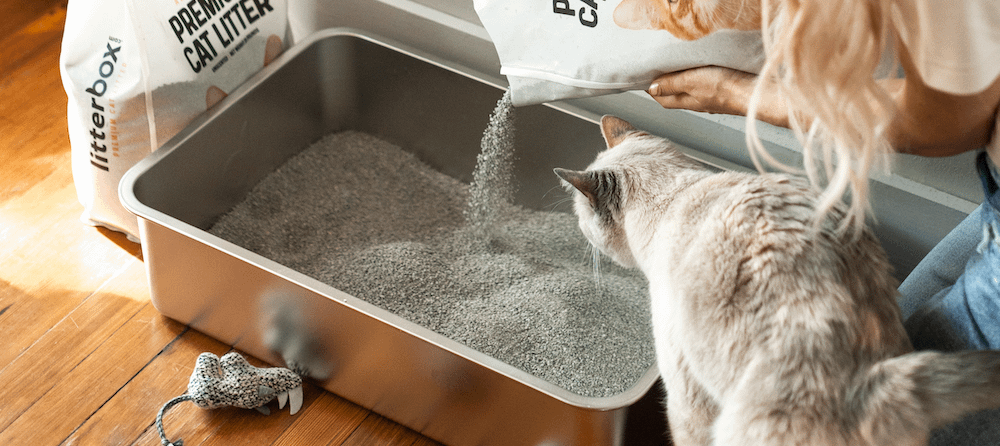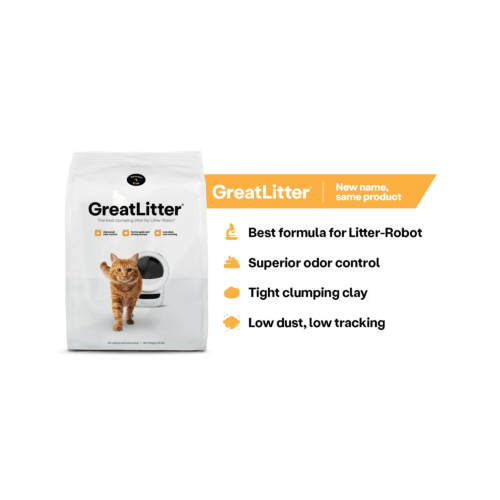There’s no denying that a disposable cat litter box is convenient in certain circumstances—like traveling a long distance with your cat (which we don’t recommend unless absolutely necessary). However, it’s important to consider the downsides before switching to disposable litter boxes.
Downsides of disposable litter boxes
1. Disposable litter boxes are hard to clean.
Cleanup may be a breeze at the end of the month when you can throw the entire litter box out. But what about the scooping you’ll still need to do every day? (Reminder: Scooping daily is important for your cat’s kidney and urinary health.)
Regardless of the type of litter used, cat urine in particular is a “sticking” point when it comes to cleaning the litter box. Most cat parents have done their fair share of scraping ammonia-reeking litter off the box. Disposable litter boxes are generally constructed of paper and other recycled materials (which is excellent!). However, some of these litter box designs include ridges, grooves, and corners that you’ll have a difficult time getting a litter scooper in. Furthermore, the very construction of disposable litter boxes means they are not tear- or shred-proof. So, if you have a kitty that likes to dig around using his nails, you’re going to end up with even more hard-to-clean grooves in the box.
However, with our cleaning tips guide, you'll be better suited for cleaning your litter box.
2. With multiple cats, the costs add up.
Most disposable cat litter boxes are supposed to last up to four weeks, and each one typically costs anywhere from $3 to $20. The lower end of that scale sounds like a negligible transaction, even month over month. However, we mustn't forget the golden rule regarding the number of litter boxes: You should have n+1 traditional litter boxes per cat. So, if you have 3 cats, you need 3+1 litter boxes (a total of 4).
With that in mind, you’ll need to purchase 3-4 disposable litter boxes monthly if you have even two cats. Again, that doesn’t add up to too much on the low end of the range—until you think about the average lifetime of your kitties. Most indoor-only cats can live 12 to 20 years. That means that in a two-cat household, you’ll spend $1,296-$2,160 at a minimum on disposable litter boxes over the cats’ lifetimes. Maximum? $8,640-$14,400. Ouch!
3. Disposable litter boxes are not as green as you think.
We’ve established that most disposable litter boxes are made of recycled materials. However, some of their manufacturers tout that because these boxes are constructed of recycled and biodegradable materials, you can in turn recycle them upon disposal.
Do not recycle your disposable litter box! Why? Cats can shed parasites and other zoonotic diseases in their feces, including toxoplasmosis, salmonella or campylobacter, and gastrointestinal worms. This is why we don’t advocate for cat toilet training (or flushing your cat’s waste down the toilet). Bottom line: A disposable litter box belongs in the garbage.
Finally, the environmental cost of continually making and shipping a new litter box vastly outweighs the benefits of using upcycled materials. At the end of the day (or month, in this case), you’re still putting trash out on the curb when you might otherwise not be.

4. You may be unable to use your cat’s preferred litter.
Disposable cat litter boxes are not well-suited for clay-clumping litter. Many customers report that this type of litter gets “gunked up” against the box's base, making it even more difficult to clean. This is likely due to urine content degrading the material, despite manufacturers promising that their boxes are “highly absorbent.”
This may not be an issue if your cat prefers silica or plant-based litter. But studies show that most cats prefer clumping, unscented litter. Another potential issue here is that disposable litter boxes often incorporate baking soda to neutralize odors. This scent may also be off-putting to your cat.
5. You still have to scoop.
Finally, the most basic downside to a disposable cat litter box, or any traditional litter box, is that you still have to scoop the waste. We can all agree: Scooping stinks. But it’s essential to clean the litter box on a daily basis, especially if you have multiple cats. Veterinarians stress that a dirty litter box can lead to medical problems in cats.
Alternatives to disposable litter boxes
The main benefit of a disposable litter box is that it is purportedly easier to clean: You scoop as needed, dispose of it at the end of the month, and start the whole process over.
Now that we’ve discussed the downsides of this type of litter box, let’s consider other options.
Traditional stainless steel litter boxes
If you’d prefer to stick with a traditional litter box design (scooping included), you can’t do better than stainless steel litter boxes. These are among the best litter boxes for odor control. Because stainless steel doesn’t absorb stains and odors, these boxes are long-lasting and easy to clean. They remain rust-free no matter how many times you clean them. Look for an ergonomic design with rounded edges, no sharp sides, and non-slip rubber feet.
Avoid plastic litter boxes, which can easily develop a buildup of urine and feces residue if improperly cleaned and maintained.
When you purchase traditional litter boxes, remember to follow the golden litter box rule: have as many litter boxes as you have cats, plus one. This is especially important when choosing the best litter box for multiple cats.
Litter box liners
Instead of disposing of your entire litter box, you can use disposable litter box liners in a traditional litter box. Liners make it easy to dispose of old litter and may help you avoid cleaning the actual box so often.
However, you still need to scoop the litter box on a daily basis. Some pet parents find litter box liners difficult to use because they may rip while you’re scooping. Other cons of litter box liners include their added cost and the fact that they’re not typically environmentally friendly.
Self-cleaning litter boxes
Instead of having a clean litter box only once a month and adding to landfills, why not reap the benefits all day, every day, while saving on the amount of cat litter used? You can, with automatic, self-cleaning litter boxes.

A self-cleaning litter box like Litter-Robot 4 quietly sifts waste into a tightly sealed drawer, trapping odors and providing a fresh bed of litter for your cats every time. No scooping is required, and litter box maintenance is minimal. You simply empty the waste drawer when it’s full and top off litter as needed. (A deep cleaning is recommended every 1-3 months, depending on how many cats you have and how messy they are.)
Of course, a self-cleaning litter box is not in everyone’s budget. But compare that up-front cost with what you may be spending on disposable litter boxes over your cat’s lifetime (see point #2 if you forgot)… Plus, self-cleaning litter boxes like Litter-Robot enable you to save over 60% on cat litter compared to regular litter boxes according to a study! Suddenly, never scooping again—plus having a clean bed of litter for your cat every time—seems much more attainable.
For litter box tips, check out our full litter box guide.
